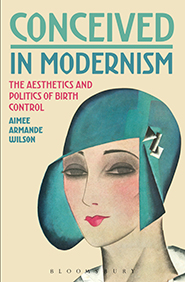Indiana University of Pennsylvania's Women's and Gender Studies is sponsoring a double book launch and conversation with the authors event at 5:00 p.m. on March 28, 2016 at the IUP University Museum.
The event is designed to celebrate the achievements of Women's and Gender Studies faculty and to raise awareness of the ongoing need for women's and gender studies and the important place that they hold in the campus-wide dialogue on diversity.
Drs. Christian Vaccaro and Melissa Swauger, two faculty members in the department of sociology, have authored “Unleashing Manhood in the Cage: Masculinity and Mixed Martial Arts.”
Dr. Aimee Wilson, a faculty member in the Department of English, is the author of “Conceived in Modernism: The Aesthetics and Politics of Birth Control.” The book was named one of the best non-fiction works of 2015 by “Entropy Magazine.”
The event is free and open to the community. The University Museum is located on the first floor of IUP's Sutton Hall.
“IUP, along with the rest of the country, is engaged in important discussions about the roles and rights of both women and men,” IUP Distinguished University Professor and Director of Women's and Gender Studies, Dr. Lynn Botelho, said. “These books address fundamental aspects of the conversation and highlight the important and far-reaching work performed by our faculty.”
 Vaccaro and Swauger have been “wrestling” with the analyses when it comes to the sport of Mixed Martial Arts (MMA), a very intense form of contact sport similar to a mixture of boxing, kick-boxing, and submission wrestling. They are two of only a few academics in the social sciences to publish research on the sport in their new co-authored book.
Vaccaro and Swauger have been “wrestling” with the analyses when it comes to the sport of Mixed Martial Arts (MMA), a very intense form of contact sport similar to a mixture of boxing, kick-boxing, and submission wrestling. They are two of only a few academics in the social sciences to publish research on the sport in their new co-authored book.
Their book addresses the question “Why do mixed martial arts participants endure grueling workouts and suffer through injury, with little or no pay, just to compete?” They find that the answer is because the participants enjoy a form of idolization from their supporters, each other, and culture more generally, which is linked to masculinity. In fact, MMA organizers, from the very beginning, purposefully created elements of the sport that are linked to dominant narratives about manhood.
“From the start, the culture of MMA has linked participation in the sport to key themes that Americans associate with being a real man like control, dominance, and independence. Sometimes organizers and participants have gone overboard with their depictions even to the point of backlash by mainstream culture,” first author Vaccaro said. “It's been a real balancing act we've documented that, when explored in depth, can tell us a lot about what we as a culture expect and tolerate from our men.”
The book also examines the often decorative role of women in MMA and how MMA organizers, participants, and fans are responding to female competitors. “MMA provides a lens through which to view contemporary gender inequality in sports and the role gender has played throughout sports in history,” co-author Swauger said.
In this context, men don thin open-fingered gloves, dress and act in ways that cause fear in their opponent, lock themselves in a caged enclosure, and slug it out in a fight with few rules to see who comes out on top. This all occurs while “ring girls” in high-heels and skin-tight shirts and shorts stride around outside the cage holding signs and peddling t-shirts. All this adds up to a great deal of information on the state of gender relations in America.
The book has received early praise from some of the most important scholars in the field of gender studies. Kathryn Lively of Dartmouth College says that the book is “Absolutely compelling, and just a little bit disturbing…A must read for any person concerned with the state of masculinity today.” Harry Brod of the University of Northern Iowa says the book is a “valuable synthesis of studies of sports and masculinities.”
Dr. Robert Heasley, past president of the American Men's Studies Association and former IUP professor of sociology, crafted the foreword to the book. He says: “it tells a story that is intense…you will come away with a new appreciation for how gender is created, managed, and reproduced.”
Vaccaro and Swauger selected Dr. Justin Shemanski, a 2007 graduate, as the subject for the cover of the book. Shemanski was an active MMA competitor between 2002 and 2009 with six wins and two losses. His career ended partially from surgery to remove fragments of bone that restricted full motion of his elbows, which was a complication resulting from years of contact sports including MMA.
“I was happy to serve as the subject for the cover of the book,” Shemanski said. “I have a great deal of respect for Vaccaro and Swauger as authors and think they gave the sport a thorough examination. The book is neither an angry missive nor a love letter to the sport. It is a good description, warts and all.”
 Wilson's book, “Conceived in Modernism” (published by Bloomsbury Academic), examines the roots of birth control politics in literature from the early 20th century. Jana Funke, Advanced Research Fellow at the University of Exeter, said, “‘Conceived in Modernism' intervenes forcefully in debates about modernist sexualities and the history of birth control and reproduction. Aimee Armande Wilson's politically informed and theoretically sophisticated readings of a range of canonical and lesser-known literary authors and birth control activists are illuminating and inspiring.”
Wilson's book, “Conceived in Modernism” (published by Bloomsbury Academic), examines the roots of birth control politics in literature from the early 20th century. Jana Funke, Advanced Research Fellow at the University of Exeter, said, “‘Conceived in Modernism' intervenes forcefully in debates about modernist sexualities and the history of birth control and reproduction. Aimee Armande Wilson's politically informed and theoretically sophisticated readings of a range of canonical and lesser-known literary authors and birth control activists are illuminating and inspiring.”
“Conceived in Modernism” begins with current events, addressing debates over the so-called “contraception mandate,” a provision of the Affordable Care Act that requires most insurance plans to cover contraception with no co-pay. Wilson notes that these debates are surprisingly divisive when we consider the fact that 99 percent of American women who are at risk for pregnancy have used contraception at some point in their lives. Among a similar population of British women, 75 percent admit to currently using some form of contraception.
On the basis of these statistics, Wilson says, we might reasonably assume that arguments over access to and use of contraception would be relatively rare and quiet, affairs more similar to debate over benefits for veterans than abortion. Yet in these early years of the twenty-first century, contraception has sparked intense debate, showing us that, on this subject at least, public rhetoric contrasts sharply with private action.
“Conceived in Modernism” argues that these current debates over birth control reflect those of a century earlier, when birth control was illegal (it was considered obscene and often classified alongside pornography), and activists fighting for increased access to it were beginning to come together as a defined social movement. The Anglo-American birth control movement and the literary movement known as modernism came of age at the same moment (early 20thcentury) and in many of the same cities (particularly London and New York). Moreover, the politics of birth control often attracted the interest of modernist artists, and many birth control activists moved in literary circles.
The small but growing body of scholarship acknowledging the intersection of these two movements typically treats them as parallel rather than mutually influencing developments. This is an oversight of no small magnitude, because, according to Wilson, we can arrive at a better understanding of the stakes of current birth control debates if we uncover the various influences on the movement's rhetoric. “Conceived in Modernism” fills this gap in scholarship by showing that literary experiments exerted a lasting influence on the ways the birth control movement discusses race, gender, religion, and the body. By looking back to the beginnings of the Anglo-American birth control movement, this book provides new context for debates that, then as now, bear most heavily on poor women and women of color.
Wilson's book also considers the influence of the birth control movement on British and American writers. Some of the most recognizable authors of the twentieth century – among them Virginia Woolf, T.S. Eliot, and Flannery O'Connor – are discussed, each shown to have included birth control as a theme or stylistic device in their writing.
Heike Bauer, Senior Lecturer at the University of London, called “Conceived in Modernism” a “meticulously researched study” that will “appeal to anyone interested in modernism, gender, and the politics of contraception.” Wilson has also published her work in “Modern Fiction Studies,” “symploke” and “Genre: Forms of Discourse and Culture.”